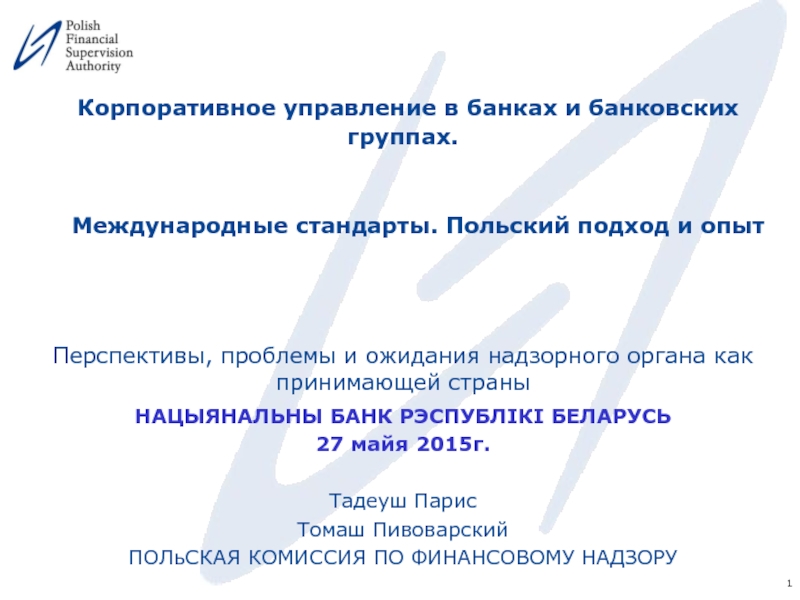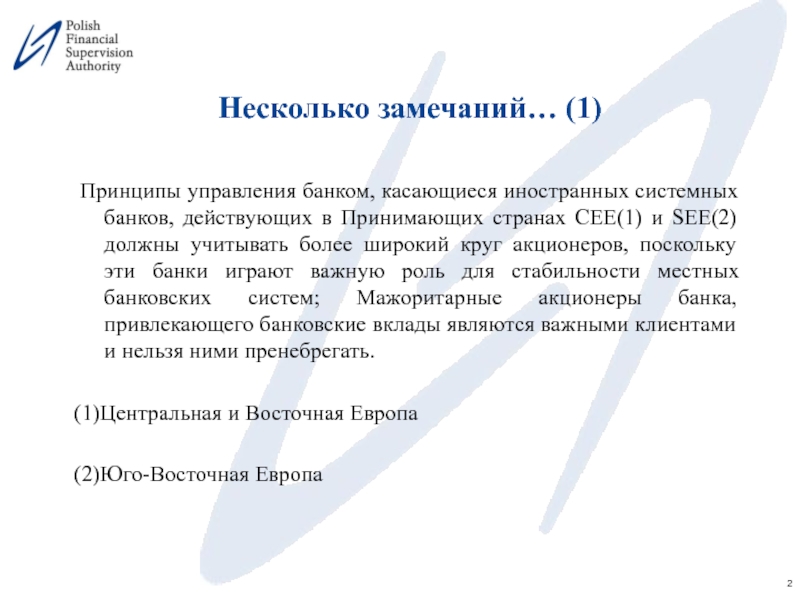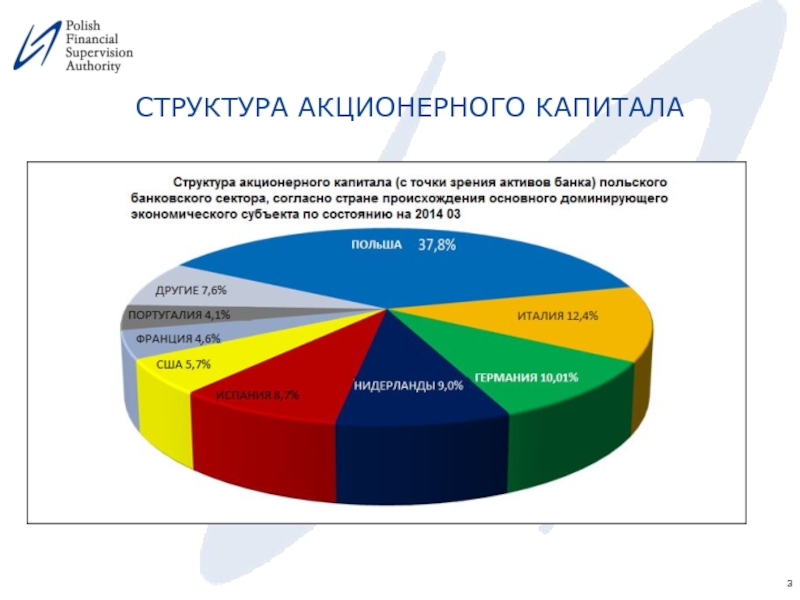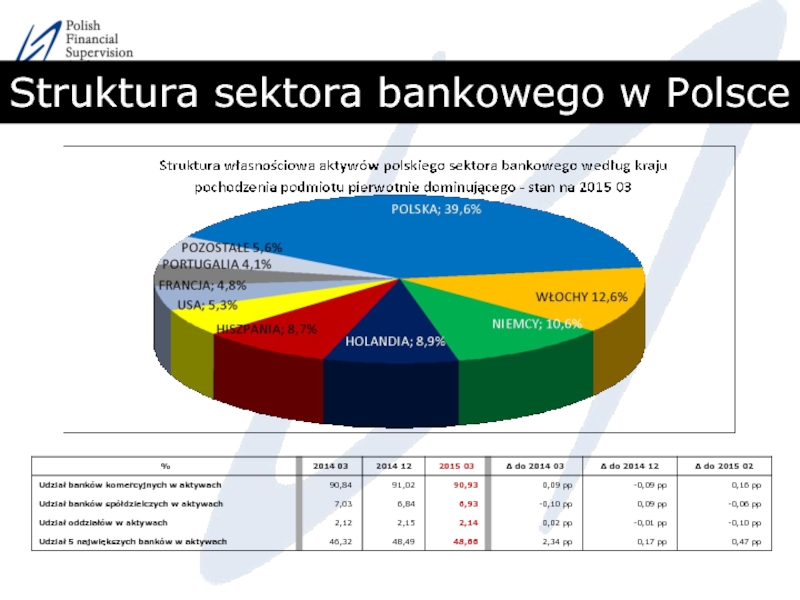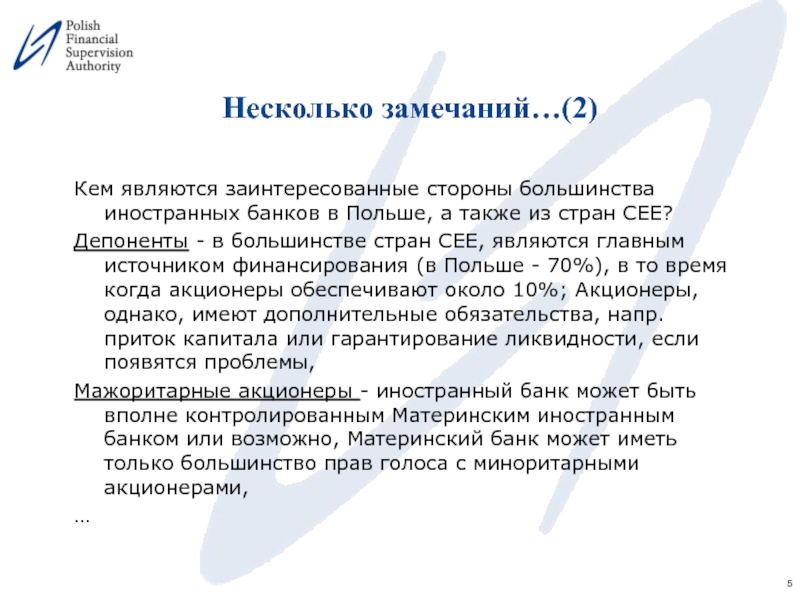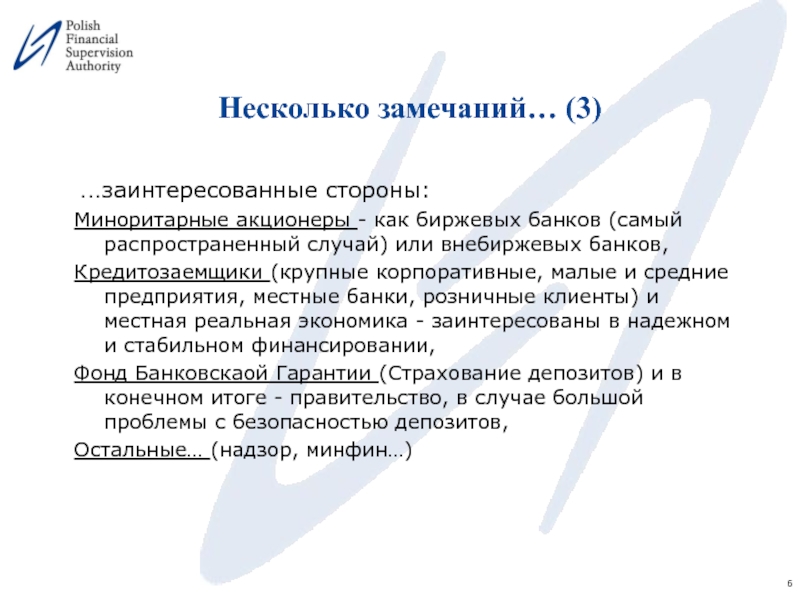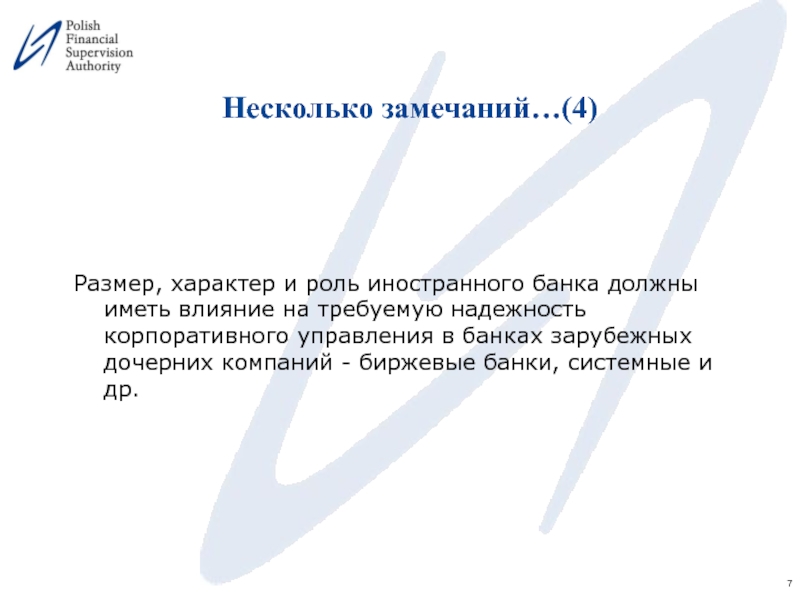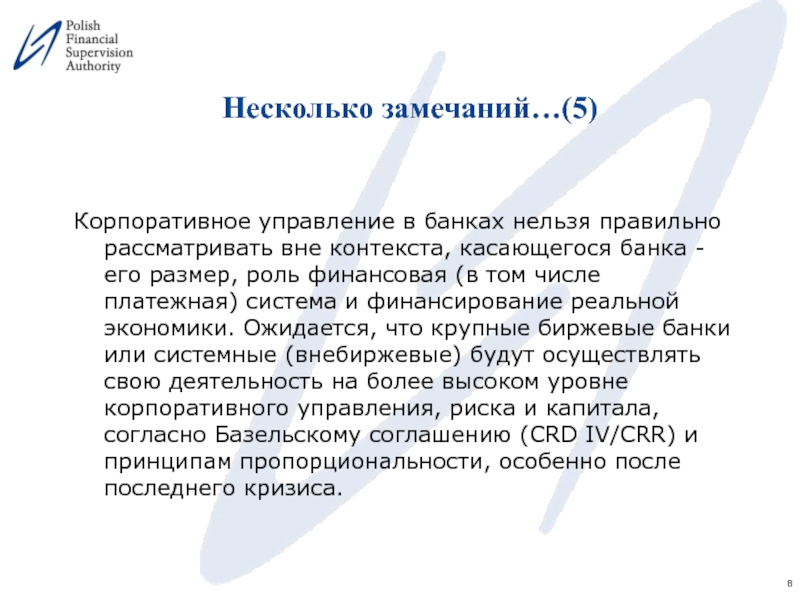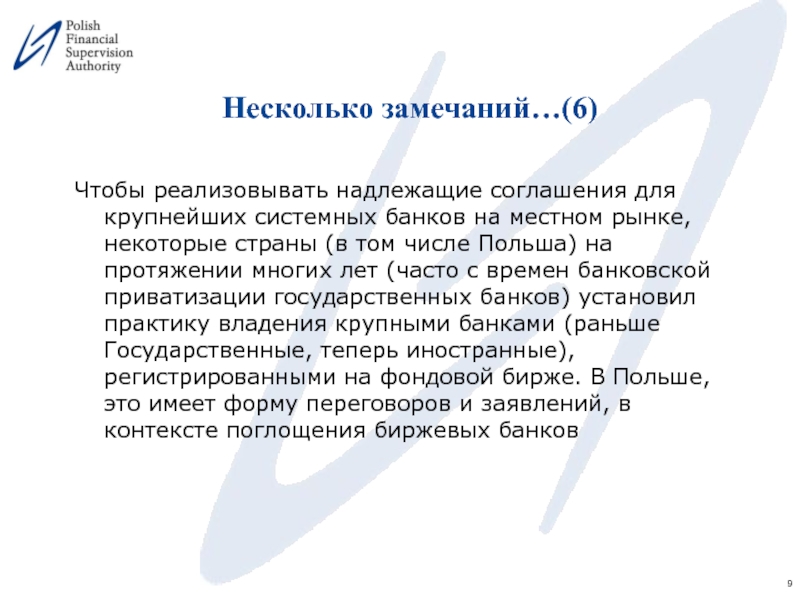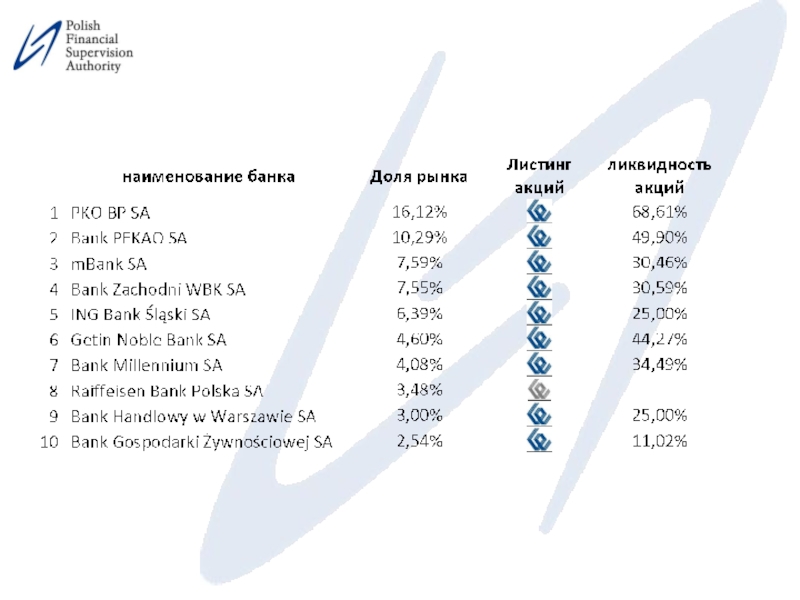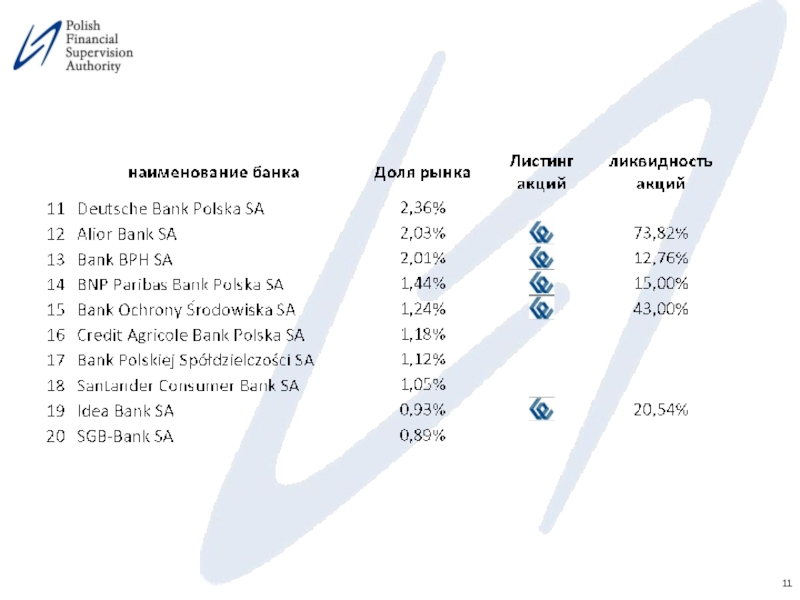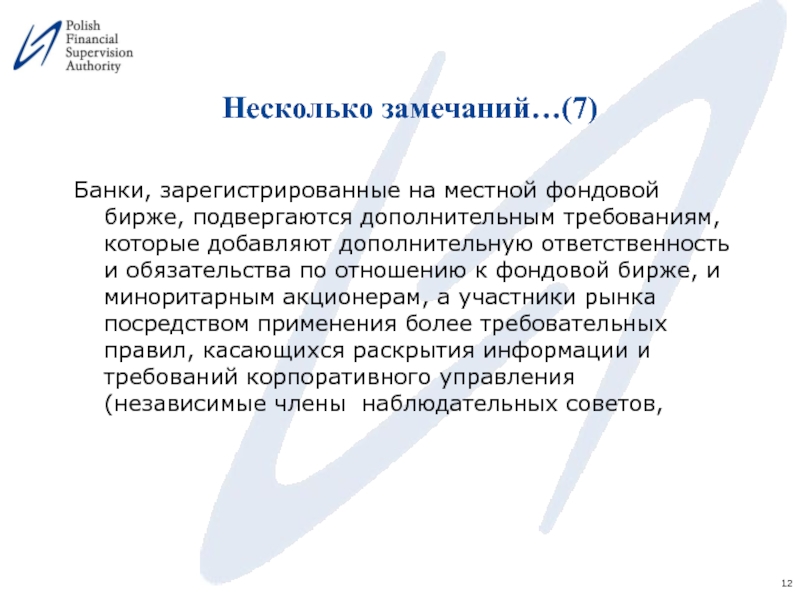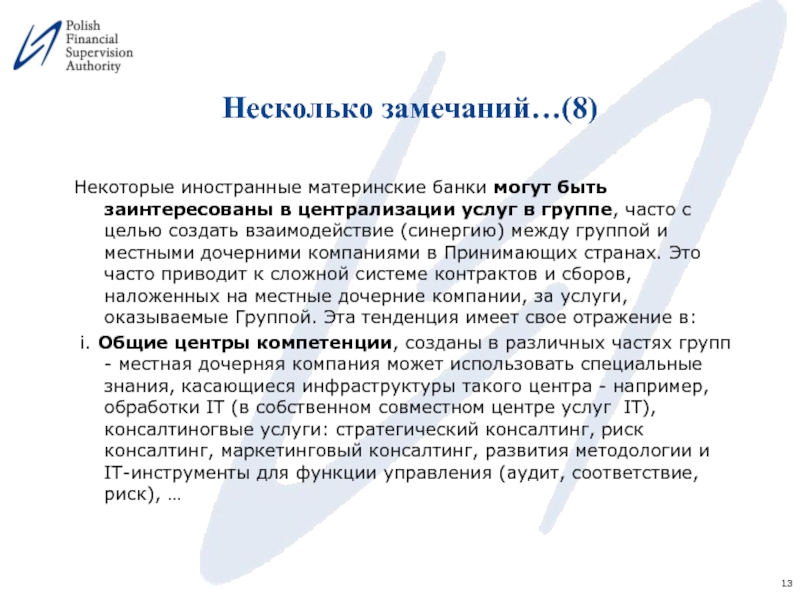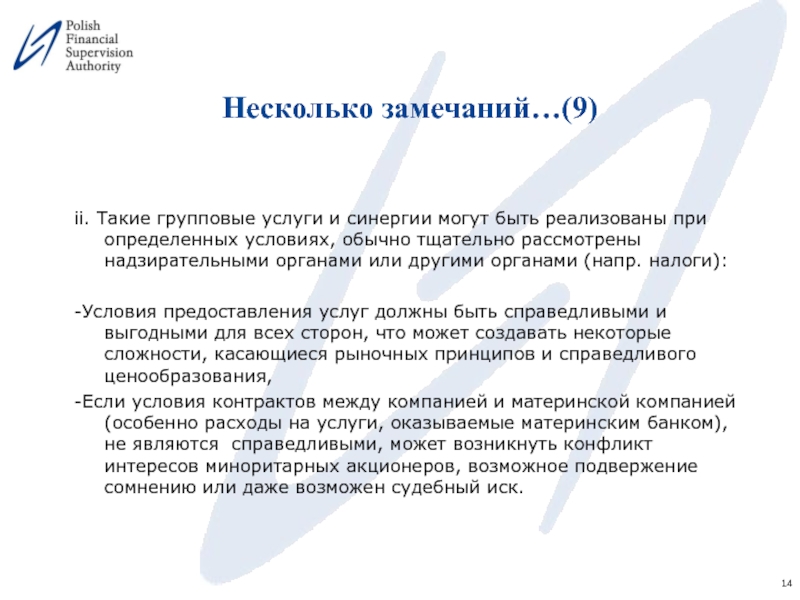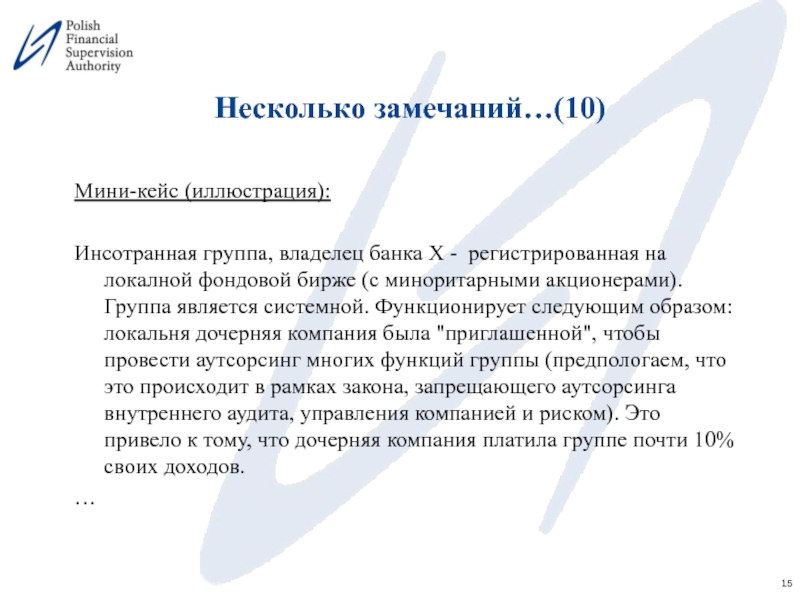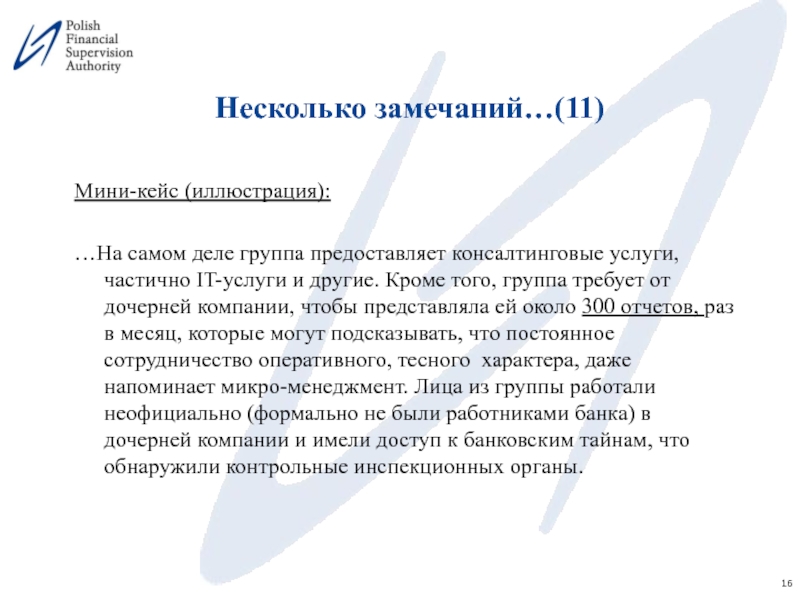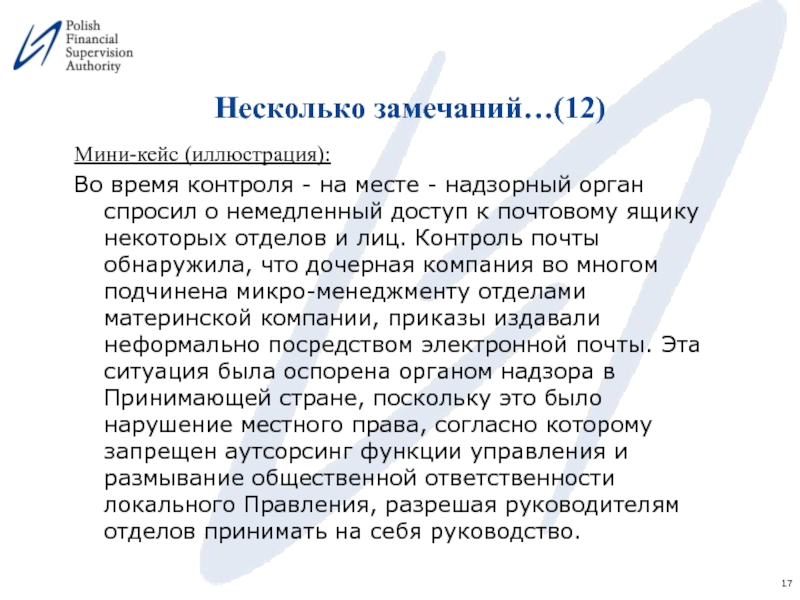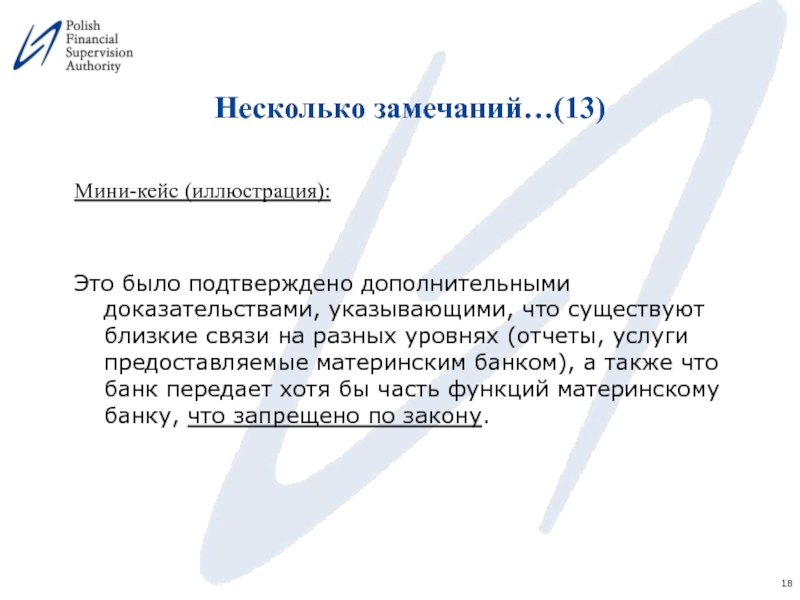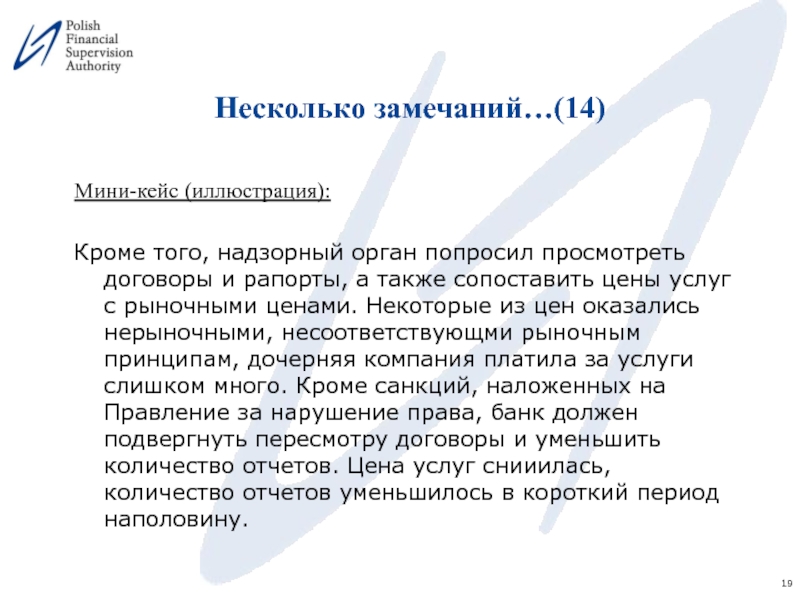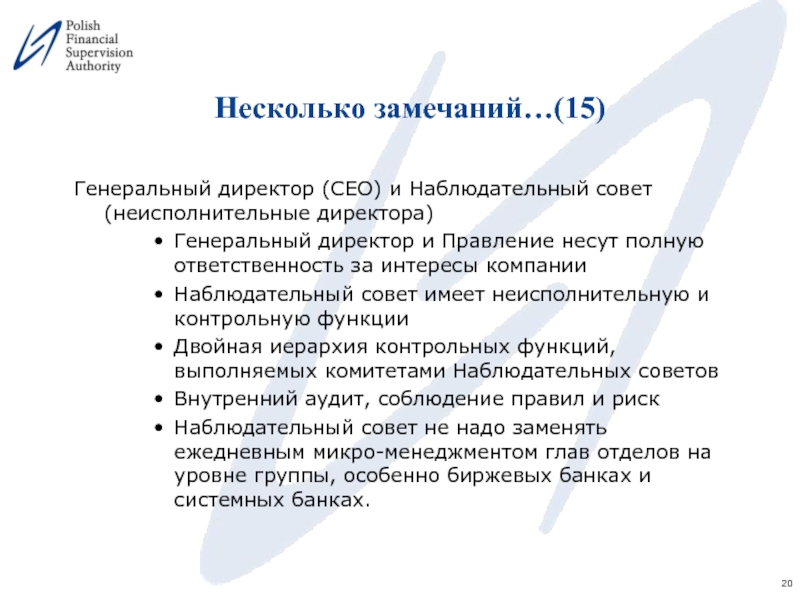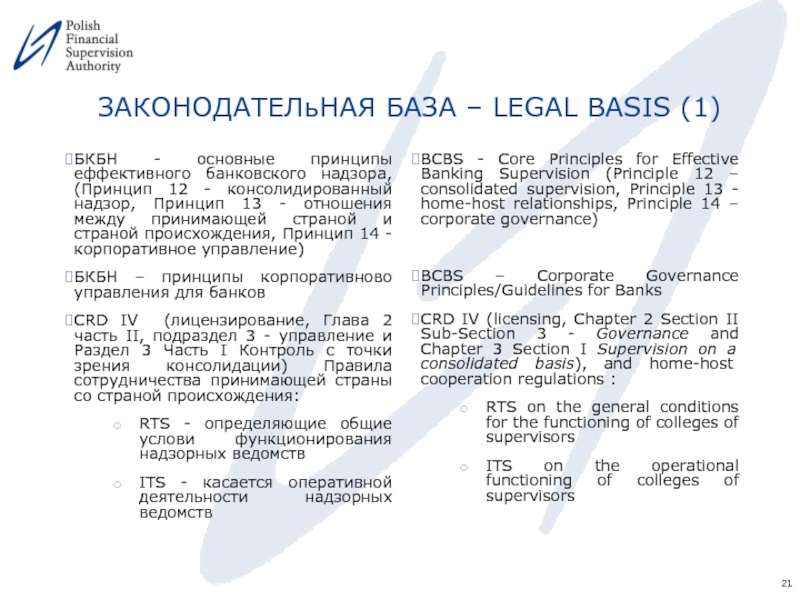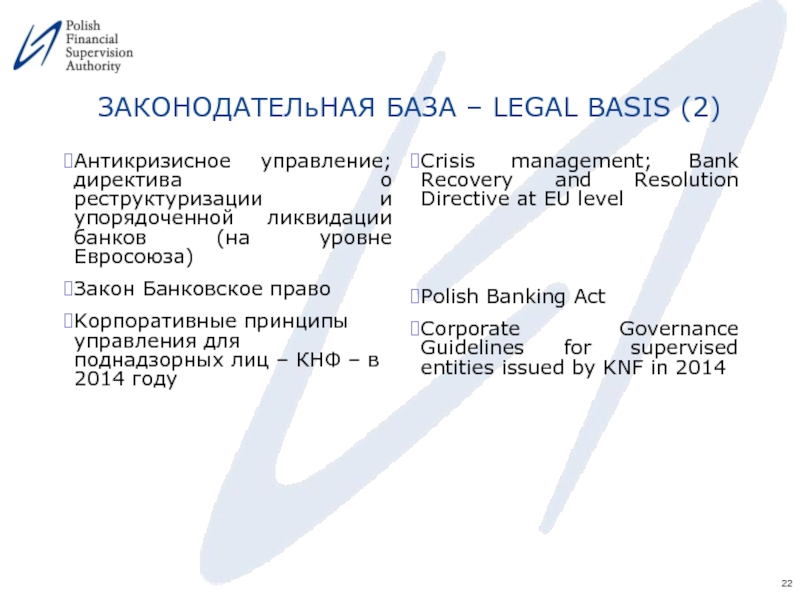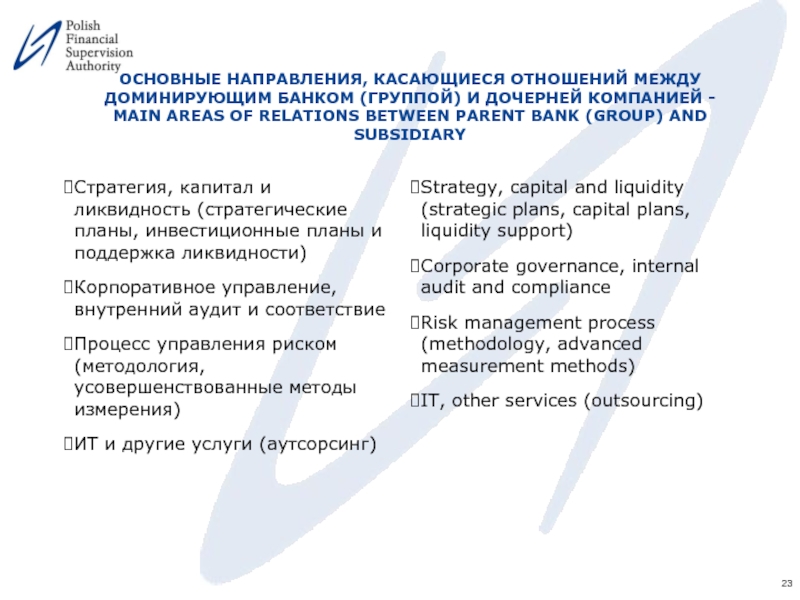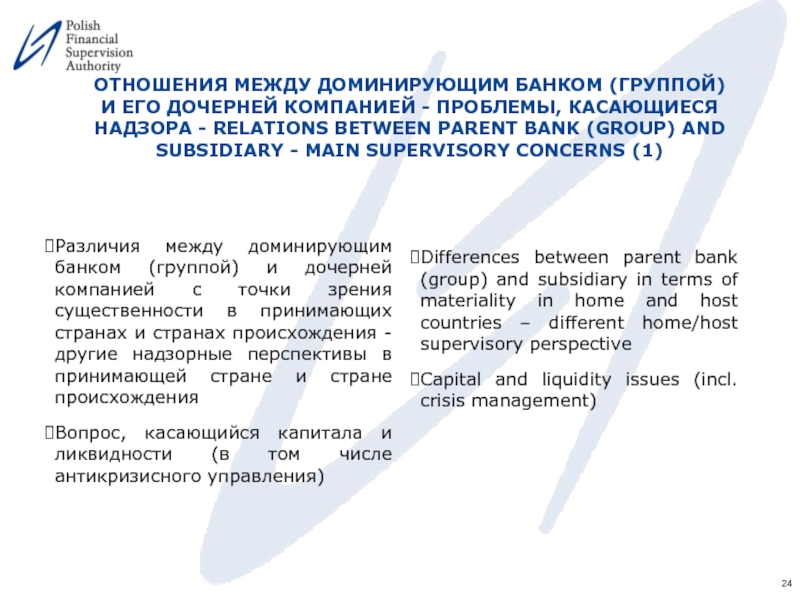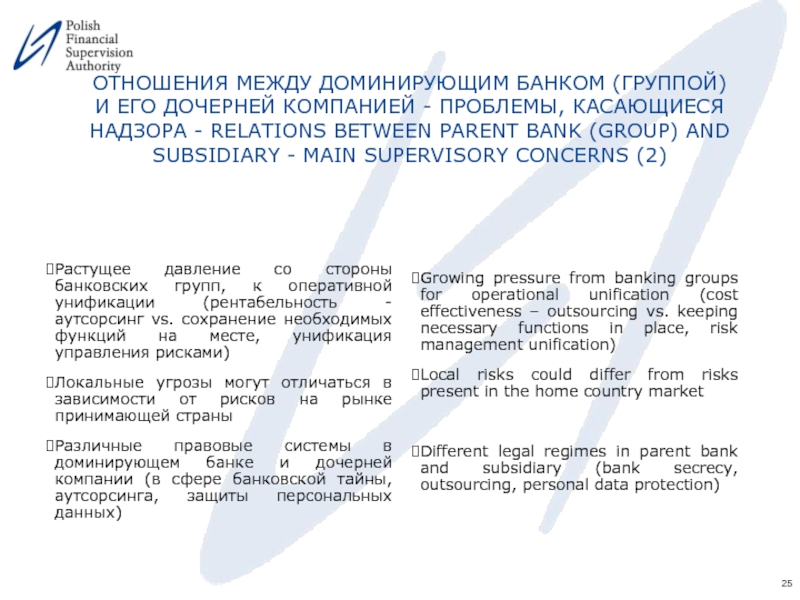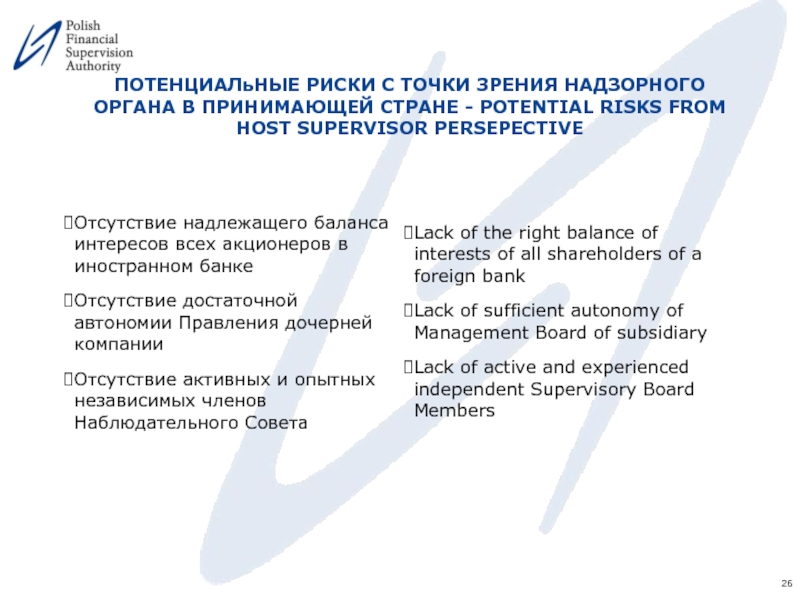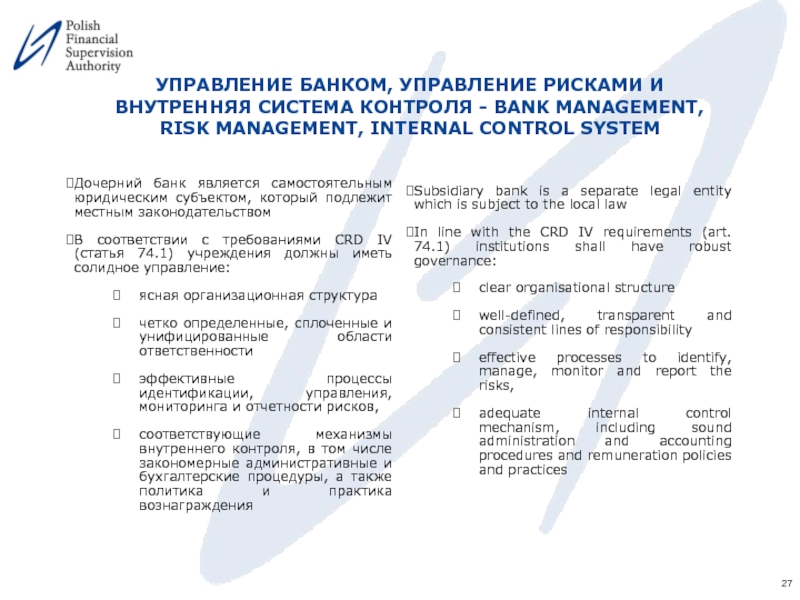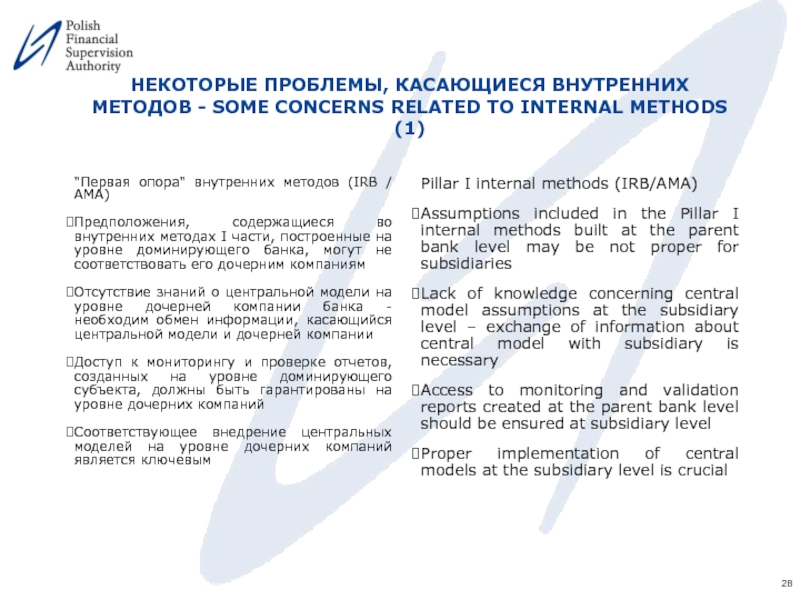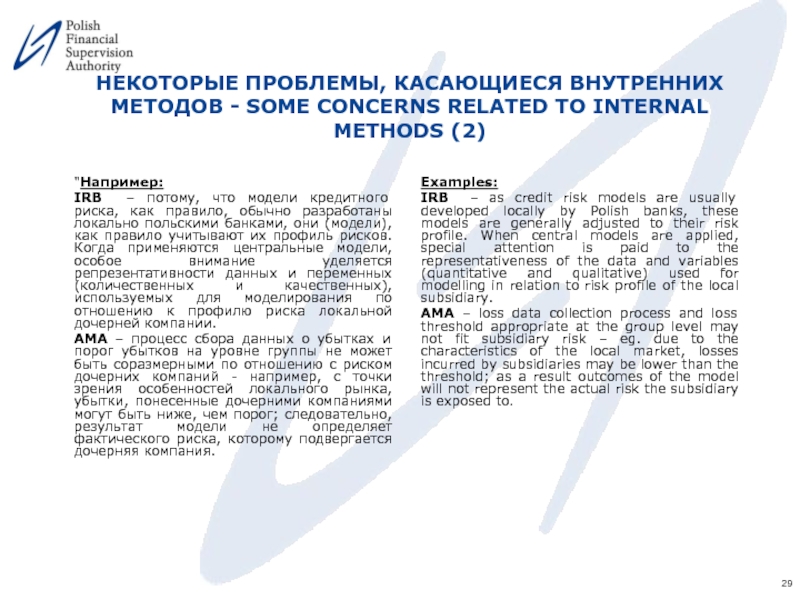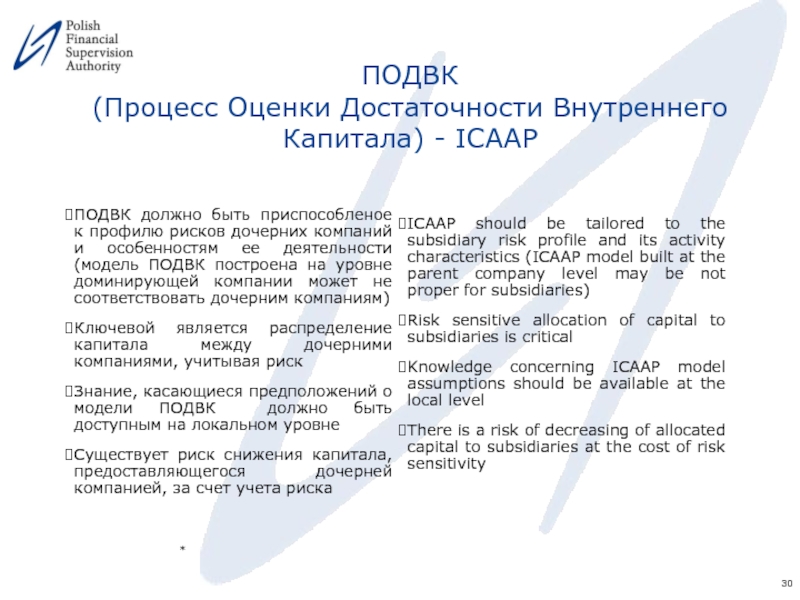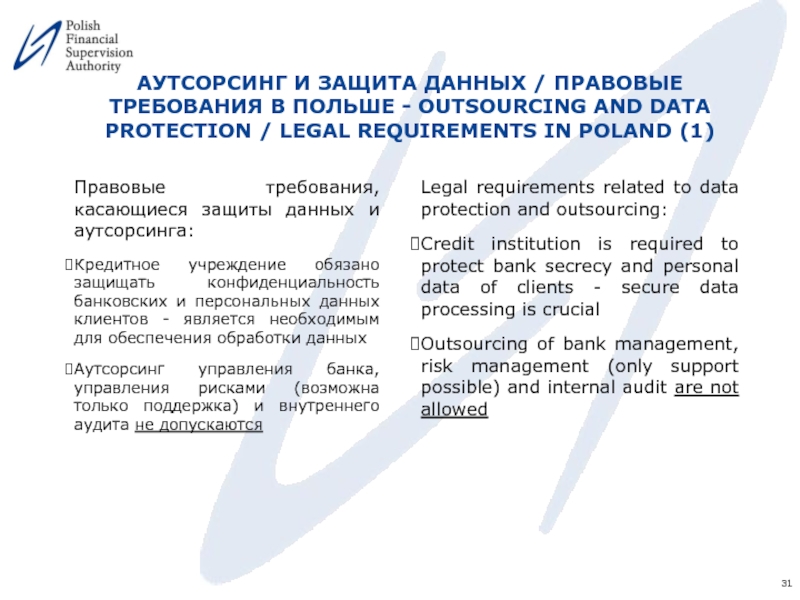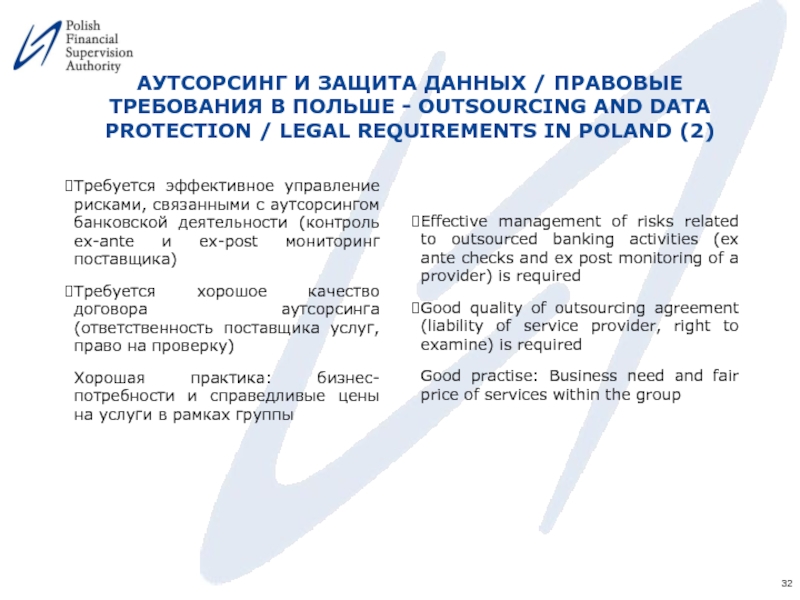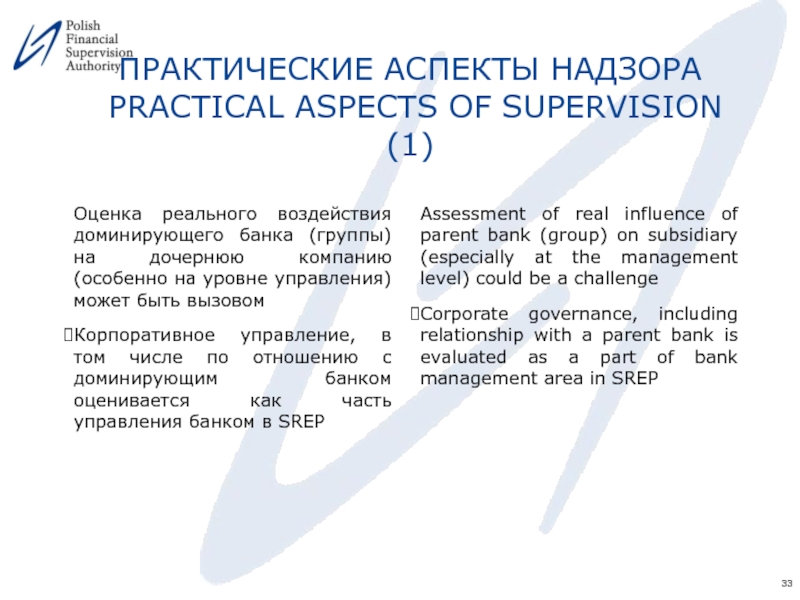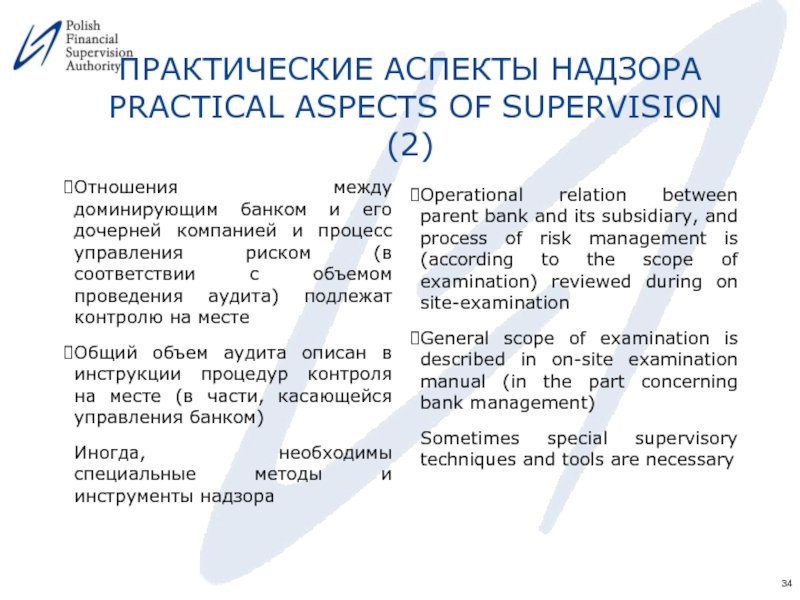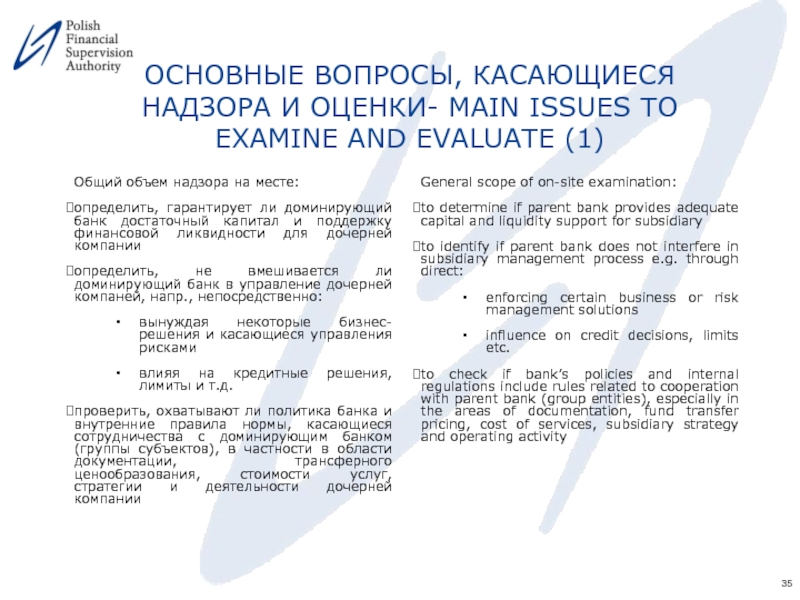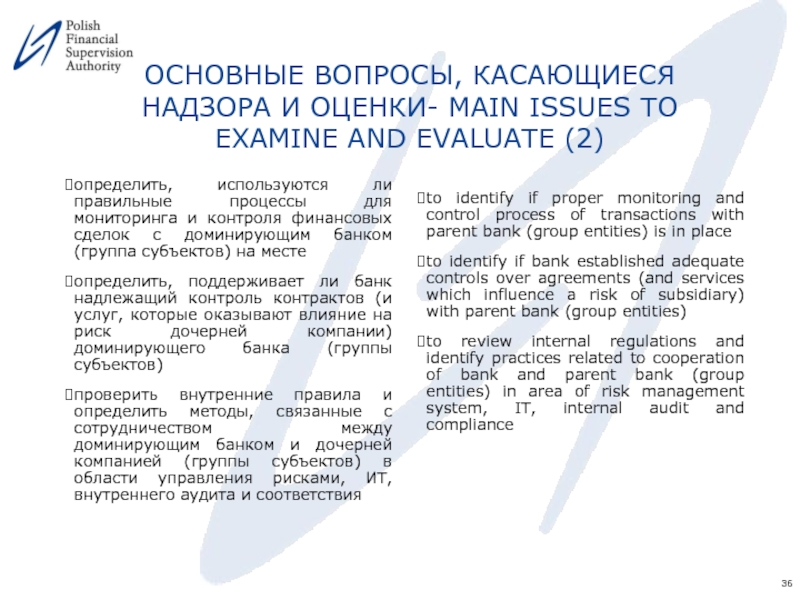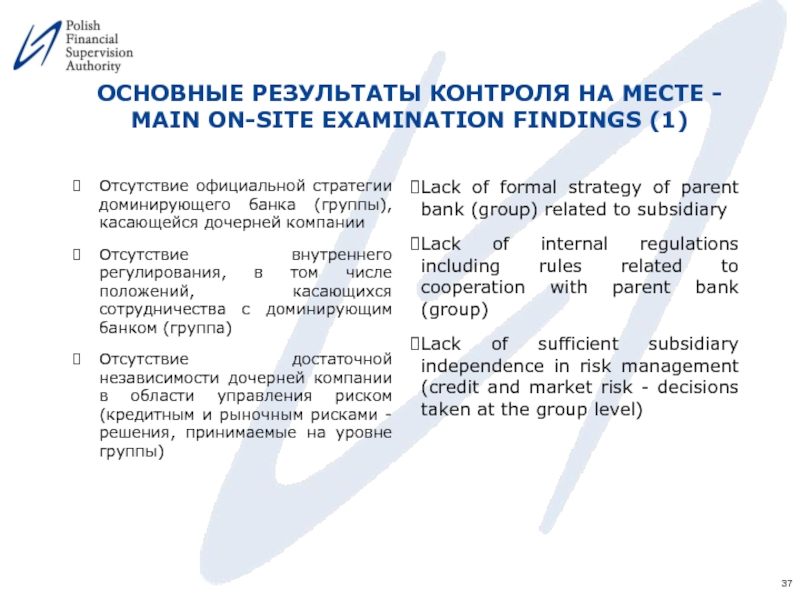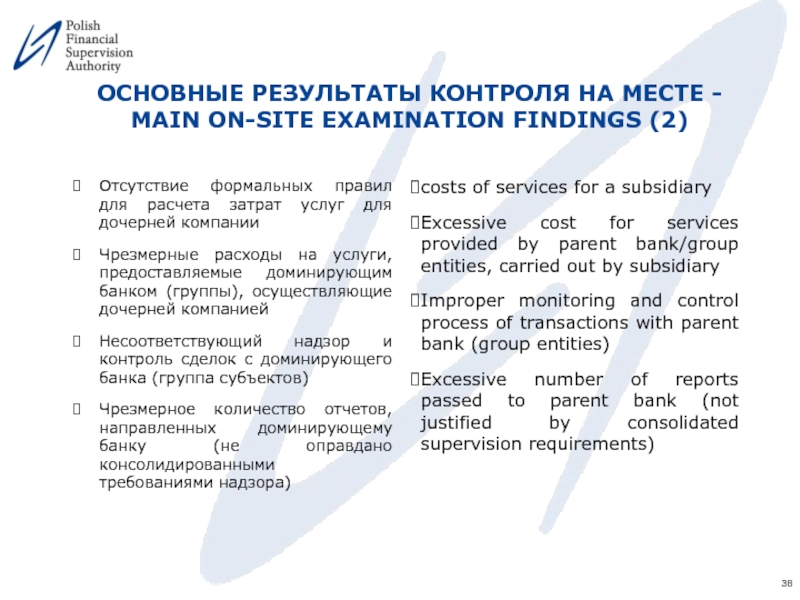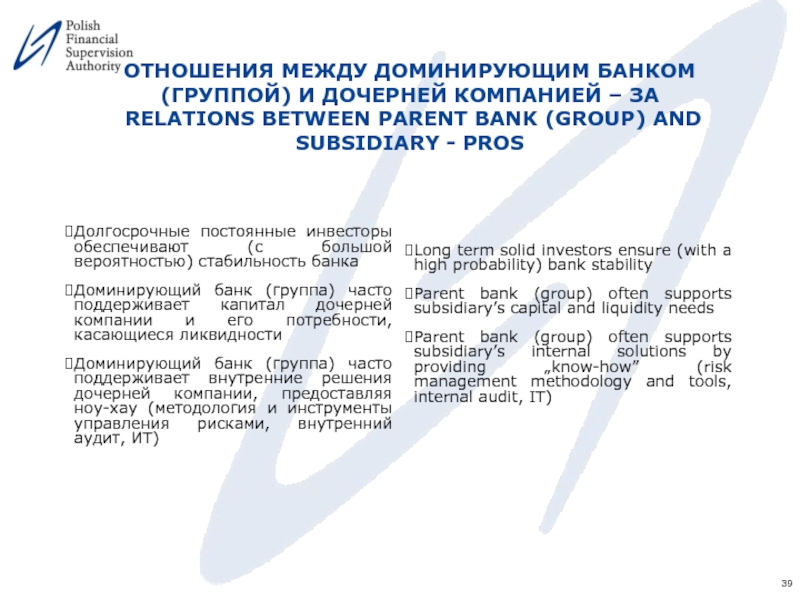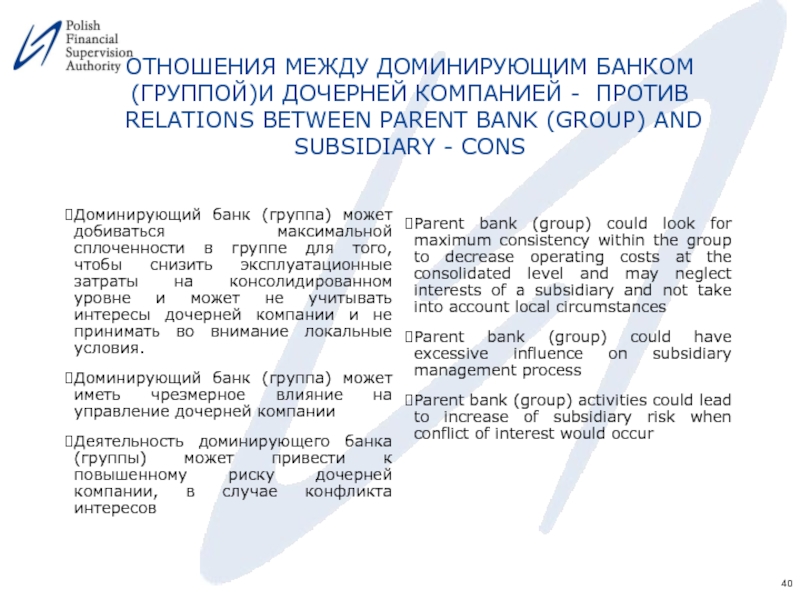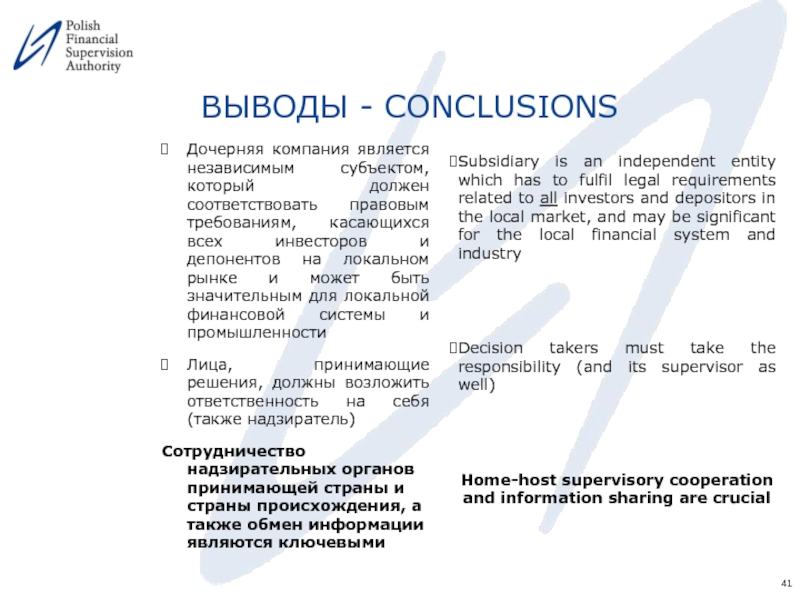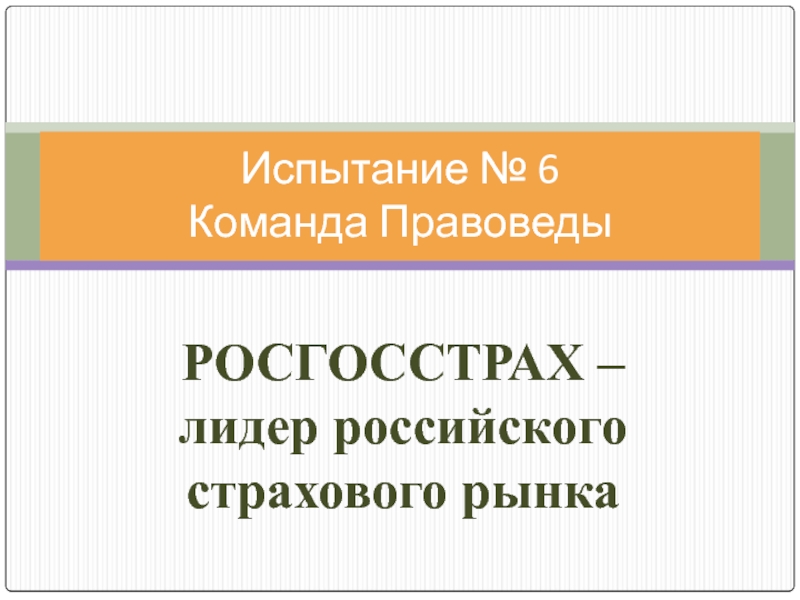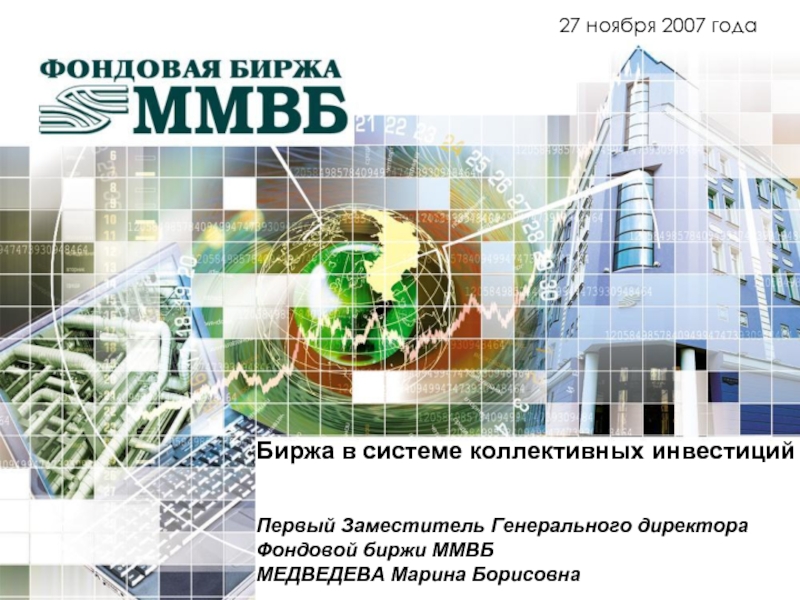НАЦЫЯНАЛЬНЫ БАНК РЭСПУБЛIКI БЕЛАРУСЬ
27 майя 2015г.
Тадеуш Парис
Томаш Пивоварский
ПОЛьСКАЯ КОМИССИЯ ПО ФИНАНСОВОМУ НАДЗОРУ
- Главная
- Разное
- Дизайн
- Бизнес и предпринимательство
- Аналитика
- Образование
- Развлечения
- Красота и здоровье
- Финансы
- Государство
- Путешествия
- Спорт
- Недвижимость
- Армия
- Графика
- Культурология
- Еда и кулинария
- Лингвистика
- Английский язык
- Астрономия
- Алгебра
- Биология
- География
- Детские презентации
- Информатика
- История
- Литература
- Маркетинг
- Математика
- Медицина
- Менеджмент
- Музыка
- МХК
- Немецкий язык
- ОБЖ
- Обществознание
- Окружающий мир
- Педагогика
- Русский язык
- Технология
- Физика
- Философия
- Химия
- Шаблоны, картинки для презентаций
- Экология
- Экономика
- Юриспруденция
Корпоративное управление в банках и банковских группах. Международные стандарты. Польский подход и опыт презентация
Содержание
- 1. Корпоративное управление в банках и банковских группах. Международные стандарты. Польский подход и опыт
- 2. Несколько замечаний… (1) Принципы управления банком,
- 3. СТРУКТУРА АКЦИОНЕРНОГО КАПИТАЛА
- 4. Struktura sektora bankowego w Polsce
- 5. Несколько замечаний…(2) Кем являются заинтересованныe стороны большинства
- 6. Несколько замечаний… (3) …заинтересованныe стороны: Миноритарные
- 7. Несколько замечаний…(4) Размер, характер
- 8. Несколько замечаний…(5) Корпоративное управление в банках
- 9. Несколько замечаний…(6) Чтобы реализовывать надлежащие соглашения для
- 12. Несколько замечаний…(7) Банки, зарегистрированные на местной фондовой
- 13. Несколько замечаний…(8) Некоторые иностранные материнские банки могут
- 14. Несколько замечаний…(9) ii. Такие групповые услуги
- 15. Несколько замечаний…(10) Мини-кейс (иллюстрация): Инсотранная группа,
- 16. Несколько замечаний…(11) Мини-кейс (иллюстрация): …На самом
- 17. Несколько замечаний…(12) Мини-кейс (иллюстрация): Во время контроля
- 18. Несколько замечаний…(13) Мини-кейс (иллюстрация): Это
- 19. Несколько замечаний…(14) Мини-кейс (иллюстрация): Кроме того,
- 20. Несколько замечаний…(15) Генеральный директор (CEO) и Наблюдательный
- 21. ЗАКОНОДАТЕЛьНАЯ БАЗА – LEGAL BASIS (1) БКБН
- 22. ЗАКОНОДАТЕЛьНАЯ БАЗА – LEGAL BASIS (2) Антикризисное
- 23. ОСНОВНЫЕ НАПРАВЛЕНИЯ, КАСАЮЩИЕСЯ ОТНОШЕНИЙ МЕЖДУ ДОМИНИРУЮЩИМ БАНКОМ
- 24. ОТНОШЕНИЯ МЕЖДУ ДОМИНИРУЮЩИМ БАНКОМ (ГРУППОЙ) И
- 25. ОТНОШЕНИЯ МЕЖДУ ДОМИНИРУЮЩИМ БАНКОМ (ГРУППОЙ) И
- 26. ПОТЕНЦИАЛьНЫЕ РИСКИ С ТОЧКИ ЗРЕНИЯ НАДЗОРНОГО ОРГАНА
- 27. УПРАВЛЕНИЕ БАНКОМ, УПРАВЛЕНИЕ РИСКАМИ И ВНУТРЕННЯЯ СИСТЕМА
- 28. НЕКОТОРЫЕ ПРОБЛЕМЫ, КАСАЮЩИЕСЯ ВНУТРЕННИХ МЕТОДОВ - SOME
- 29. НЕКОТОРЫЕ ПРОБЛЕМЫ, КАСАЮЩИЕСЯ ВНУТРЕННИХ МЕТОДОВ - SOME
- 30. ПОДВК (Процесс Оценки Достаточности Внутреннего Капитала) -
- 31. АУТСОРСИНГ И ЗАЩИТА ДАННЫХ / ПРАВОВЫЕ ТРЕБОВАНИЯ
- 32. АУТСОРСИНГ И ЗАЩИТА ДАННЫХ / ПРАВОВЫЕ ТРЕБОВАНИЯ
- 33. ПРАКТИЧЕСКИЕ АСПЕКТЫ НАДЗОРА PRACTICAL ASPECTS OF
- 34. ПРАКТИЧЕСКИЕ АСПЕКТЫ НАДЗОРА PRACTICAL ASPECTS OF
- 35. ОСНОВНЫЕ ВОПРОСЫ, КАСАЮЩИЕСЯ НАДЗОРА И ОЦЕНКИ- MAIN
- 36. ОСНОВНЫЕ ВОПРОСЫ, КАСАЮЩИЕСЯ НАДЗОРА И ОЦЕНКИ- MAIN
- 37. ОСНОВНЫЕ РЕЗУЛЬТАТЫ КОНТРОЛЯ НА МЕСТЕ - MAIN
- 38. ОСНОВНЫЕ РЕЗУЛЬТАТЫ КОНТРОЛЯ НА МЕСТЕ - MAIN
- 39. ОТНОШЕНИЯ МЕЖДУ ДОМИНИРУЮЩИМ БАНКОМ (ГРУППОЙ) И ДОЧЕРНЕЙ
- 40. ОТНОШЕНИЯ МЕЖДУ ДОМИНИРУЮЩИМ БАНКОМ (ГРУППОЙ)И ДОЧЕРНЕЙ КОМПАНИЕЙ
- 41. ВЫВОДЫ - CONCLUSIONS Дочерняя компания является независимым
- 42. СЛЕДУЕТ ПРОДУМАТь …. FOR CONSIDERATION ….
- 43. СЛЕДУЕТ ПРОДУМАТь …. FOR CONSIDERATION ….
- 44. Tomasz.Piwowarski@knf.gov.pl Tadeusz.Parys@knf.gov.pl дзякуй !
Слайд 1 Корпоративное управление в банках и банковских группах. Международные стандарты.
Слайд 2Несколько замечаний… (1)
Принципы управления банком, касающиеся иностранных системных банков, действующих
(1)Центральная и Восточная Европа
(2)Юго-Восточная Европа
Слайд 5Несколько замечаний…(2)
Кем являются заинтересованныe стороны большинства иностранных банков в Польше, а
Депоненты - в большинстве стран CEE, являются главным источником финансирования (в Польше - 70%), в то время когда акционеры обеспечивают около 10%; Акционеры, однако, имеют дополнительные обязательства, напр. приток капитала или гарантирование ликвидности, если появятся проблемы,
Мажоритарные акционеры - иностранный банк может быть вполне контролированным Материнским иностранным банком или возможно, Материнский банк может иметь только большинство прав голоса с миноритарными акционерами,
…
Слайд 6Несколько замечаний… (3)
…заинтересованныe стороны:
Миноритарные акционеры - как биржевых банков (самый
Кредитозаемщики (крупные корпоративные, малые и средние предприятия, местные банки, розничные клиенты) и местная реальная экономика - заинтересованы в надежном и стабильном финансировании,
Фонд Банковскаой Гарантии (Страхование депозитов) и в конечном итоге - правительство, в случае большой проблемы с безопасностью депозитов,
Остальные… (надзор, минфин…)
Слайд 7Несколько замечаний…(4)
Размер, характер и роль иностранного банка должны иметь влияние на
Слайд 8Несколько замечаний…(5)
Корпоративное управление в банках нельзя правильно рассматривать вне контекста, касающегося
Слайд 9Несколько замечаний…(6)
Чтобы реализовывать надлежащие соглашения для крупнейших системных банков на местном
Слайд 12Несколько замечаний…(7)
Банки, зарегистрированные на местной фондовой бирже, подвергаются дополнительным требованиям, которые
Слайд 13Несколько замечаний…(8)
Некоторые иностранные материнские банки могут быть заинтересованы в централизации услуг
i. Общие центры компетенции, созданы в различных частях групп - местная дочерняя компания может использовать специальные знания, касающиеся инфраструктуры такого центра - например, обработки IT (в собственном совместном центре услуг IT), консалтиногвые услуги: стратегический консалтинг, риск консалтинг, маркетинговый консалтинг, развития методологии и IT-инструменты для функции управления (аудит, соответствие, риск), …
Слайд 14Несколько замечаний…(9)
ii. Такие групповые услуги и синергии могут быть реализованы при
-Условия предоставления услуг должны быть справедливыми и выгодными для всех сторон, что может создавать некоторые сложности, касающиеся рыночных принципов и справедливого ценообразования,
-Если условия контрактов между компанией и материнской компанией (особенно расходы на услуги, оказываемые материнским банком), не являются справедливыми, может возникнуть конфликт интересов миноритарных акционеров, возможное подвержение сомнению или даже возможен судебный иск.
Слайд 15Несколько замечаний…(10)
Мини-кейс (иллюстрация):
Инсотранная группа, владелец банка Х - регистрированная на локалной
…
Слайд 16Несколько замечаний…(11)
Мини-кейс (иллюстрация):
…На самом деле группа предоставляет консалтинговые услуги, частично IT-услуги
Слайд 17Несколько замечаний…(12)
Мини-кейс (иллюстрация):
Во время контроля - на месте - надзорный орган
Слайд 18Несколько замечаний…(13)
Мини-кейс (иллюстрация):
Это было подтверждено дополнительными доказательствами, указывающими, что существуют близкие
Слайд 19Несколько замечаний…(14)
Мини-кейс (иллюстрация):
Кроме того, надзорный орган попросил просмотреть договоры и рапорты,
Слайд 20Несколько замечаний…(15)
Генеральный директор (CEO) и Наблюдательный совет (неисполнительные директора)
Генеральный директор и
Наблюдательный совет имеет неисполнительную и контрольную функции
Двойная иерархия контрольных функций, выполняемых комитетами Наблюдательных советов
Внутренний аудит, соблюдение правил и риск
Наблюдательный совет не надо заменять ежедневным микро-менеджментом глав отделов на уровне группы, особенно биржевых банках и системных банках.
Слайд 21ЗАКОНОДАТЕЛьНАЯ БАЗА – LEGAL BASIS (1)
БКБН - основные принципы еффективного банковского
БКБН – принципы корпоративново управления для банков
CRD IV (лицензирование, Глава 2 часть II, подраздел 3 - управление и Раздел 3 Часть I Контроль с точки зрения консолидации) Правила сотрудничества принимающей страны со страной происхождения:
RTS - определяющие общие услови функционирования надзорных ведомств
ITS - касается оперативной деятельности надзорных ведомств
BCBS - Core Principles for Effective Banking Supervision (Principle 12 – consolidated supervision, Principle 13 - home-host relationships, Principle 14 – corporate governance)
BCBS – Corporate Governance Principles/Guidelines for Banks
CRD IV (licensing, Chapter 2 Section II Sub-Section 3 - Governance and Chapter 3 Section I Supervision on a consolidated basis), and home-host cooperation regulations :
RTS on the general conditions for the functioning of colleges of supervisors
ITS on the operational functioning of colleges of supervisors
Слайд 22ЗАКОНОДАТЕЛьНАЯ БАЗА – LEGAL BASIS (2)
Антикризисное управление; директива о реструктуризации и
Закон Банковское право
Kорпоративные принципы управления для поднадзорных лиц – КНФ – в 2014 году
Crisis management; Bank Recovery and Resolution Directive at EU level
Polish Banking Act
Corporate Governance Guidelines for supervised entities issued by KNF in 2014
Слайд 23ОСНОВНЫЕ НАПРАВЛЕНИЯ, КАСАЮЩИЕСЯ ОТНОШЕНИЙ МЕЖДУ ДОМИНИРУЮЩИМ БАНКОМ (ГРУППОЙ) И ДОЧЕРНЕЙ КОМПАНИЕЙ
Стратегия, капитал и ликвидность (стратегические планы, инвестиционные планы и поддержка ликвидности)
Корпоративное управление, внутренний аудит и соответствие
Процесс управления риском (методология, усовершенствованные методы измерения)
ИТ и другие услуги (аутсорсинг)
Strategy, capital and liquidity (strategic plans, capital plans, liquidity support)
Corporate governance, internal audit and compliance
Risk management process (methodology, advanced measurement methods)
IT, other services (outsourcing)
Слайд 24 ОТНОШЕНИЯ МЕЖДУ ДОМИНИРУЮЩИМ БАНКОМ (ГРУППОЙ) И ЕГО ДОЧЕРНЕЙ КОМПАНИЕЙ - ПРОБЛЕМЫ,
Различия между доминирующим банком (группой) и дочерней компанией с точки зрения существенности в принимающих странах и странах происхождения - другие надзорные перспективы в принимающей стране и стране происхождения
Вопрос, касающийся капитала и ликвидности (в том числе антикризисного управления)
Differences between parent bank (group) and subsidiary in terms of materiality in home and host countries – different home/host supervisory perspective
Capital and liquidity issues (incl. crisis management)
Слайд 25 ОТНОШЕНИЯ МЕЖДУ ДОМИНИРУЮЩИМ БАНКОМ (ГРУППОЙ) И ЕГО ДОЧЕРНЕЙ КОМПАНИЕЙ - ПРОБЛЕМЫ,
Растущее давление со стороны банковских групп, к оперативной унификации (рентабельность - аутсорсинг vs. сохранение необходимых функций на месте, унификация управления рисками)
Локальные угрозы могут отличаться в зависимости от рисков на рынке принимающей страны
Различные правовые системы в доминирующем банке и дочерней компании (в сфере банковской тайны, аутсорсинга, защиты персональных данных)
Growing pressure from banking groups for operational unification (cost effectiveness – outsourcing vs. keeping necessary functions in place, risk management unification)
Local risks could differ from risks present in the home country market
Different legal regimes in parent bank and subsidiary (bank secrecy, outsourcing, personal data protection)
Слайд 26ПОТЕНЦИАЛьНЫЕ РИСКИ С ТОЧКИ ЗРЕНИЯ НАДЗОРНОГО ОРГАНА В ПРИНИМАЮЩЕЙ СТРАНЕ -
Отсутствие надлежащего баланса интересов всех акционеров в иностранном банке
Отсутствие достаточной автономии Правления дочерней компании
Отсутствие активных и опытных независимых членов Наблюдательного Совета
Lack of the right balance of interests of all shareholders of a foreign bank
Lack of sufficient autonomy of Management Board of subsidiary
Lack of active and experienced independent Supervisory Board Members
Слайд 27УПРАВЛЕНИЕ БАНКОМ, УПРАВЛЕНИЕ РИСКАМИ И ВНУТРЕННЯЯ СИСТЕМА КОНТРОЛЯ - BANK MANAGEMENT,
Дочерний банк является самостоятельным юридическим субъектом, который подлежит местным законодательством
В соответствии с требованиями CRD IV (статья 74.1) учреждения должны иметь солидное управление:
ясная организационная структура
четко определенные, сплоченные и унифицированные области ответственности
эффективные процессы идентификации, управления, мониторинга и отчетности рисков,
соответствующие механизмы внутреннего контроля, в том числе закономерные административные и бухгалтерские процедуры, а также политика и практика вознаграждения
Subsidiary bank is a separate legal entity which is subject to the local law
In line with the CRD IV requirements (art. 74.1) institutions shall have robust governance:
clear organisational structure
well-defined, transparent and consistent lines of responsibility
effective processes to identify, manage, monitor and report the risks,
adequate internal control mechanism, including sound administration and accounting procedures and remuneration policies and practices
Слайд 28НЕКОТОРЫЕ ПРОБЛЕМЫ, КАСАЮЩИЕСЯ ВНУТРЕННИХ МЕТОДОВ - SOME CONCERNS RELATED TO INTERNAL
"Первая опора" внутренних методов (IRB / АМА)
Предположения, содержащиеся во внутренних методах I части, построенные на уровне доминирующего банка, могут не соответствовать его дочерним компаниям
Отсутствие знаний о центральной модели на уровне дочерней компании банка - необходим обмен информации, касающийся центральной модели и дочерней компании
Доступ к мониторингу и проверке отчетов, созданных на уровне доминирующего субъекта, должны быть гарантированы на уровне дочерних компаний
Соответствующее внедрение центральных моделей на уровне дочерних компаний является ключевым
Pillar I internal methods (IRB/AMA)
Assumptions included in the Pillar I internal methods built at the parent bank level may be not proper for subsidiaries
Lack of knowledge concerning central model assumptions at the subsidiary level – exchange of information about central model with subsidiary is necessary
Access to monitoring and validation reports created at the parent bank level should be ensured at subsidiary level
Proper implementation of central models at the subsidiary level is crucial
Слайд 29НЕКОТОРЫЕ ПРОБЛЕМЫ, КАСАЮЩИЕСЯ ВНУТРЕННИХ МЕТОДОВ - SOME CONCERNS RELATED TO INTERNAL
"Например:
IRB – потому, что модели кредитного риска, как правило, обычно разработаны локально польскими банками, они (модели), как правило учитывают их профиль рисков. Когда применяются центральные модели, особое внимание уделяется репрезентативности данных и переменных (количественных и качественных), используемых для моделирования по отношению к профилю риска локальной дочерней компании.
AMA – процесс сбора данных о убытках и порог убытков на уровне группы не может быть соразмерными по отношению с риском дочерних компаний - например, с точки зрения особенностей локального рынка, убытки, понесенные дочерними компаниями могут быть ниже, чем порог; следовательно, результат модели не определяет фактического риска, которому подвергается дочерняя компания.
Examples:
IRB – as credit risk models are usually developed locally by Polish banks, these models are generally adjusted to their risk profile. When central models are applied, special attention is paid to the representativeness of the data and variables (quantitative and qualitative) used for modelling in relation to risk profile of the local subsidiary.
AMA – loss data collection process and loss threshold appropriate at the group level may not fit subsidiary risk – eg. due to the characteristics of the local market, losses incurred by subsidiaries may be lower than the threshold; as a result outcomes of the model will not represent the actual risk the subsidiary is exposed to.
Слайд 30ПОДВК
(Процесс Оценки Достаточности Внутреннего Капитала) - ICAAP
ПОДВК должно быть приспособленое к
Ключевой является распределение капитала между дочерними компаниями, учитывая риск
Знание, касающиеся предположений о модели ПОДВК должно быть доступным на локальном уровне
Существует риск снижения капитала, предоставляющегося дочерней компанией, за счет учета риска
ICAAP should be tailored to the subsidiary risk profile and its activity characteristics (ICAAP model built at the parent company level may be not proper for subsidiaries)
Risk sensitive allocation of capital to subsidiaries is critical
Knowledge concerning ICAAP model assumptions should be available at the local level
There is a risk of decreasing of allocated capital to subsidiaries at the cost of risk sensitivity
*
Слайд 31АУТСОРСИНГ И ЗАЩИТА ДАННЫХ / ПРАВОВЫЕ ТРЕБОВАНИЯ В ПОЛЬШЕ - OUTSOURCING
Правовые требования, касающиеся защиты данных и аутсорсинга:
Кредитное учреждение обязано защищать конфиденциальность банковских и персональных данных клиентов - является необходимым для обеспечения обработки данных
Аутсорсинг управления банка, управления рисками (возможна только поддержка) и внутреннего аудита не допускаются
Legal requirements related to data protection and outsourcing:
Credit institution is required to protect bank secrecy and personal data of clients - secure data processing is crucial
Outsourcing of bank management, risk management (only support possible) and internal audit are not allowed
Слайд 32АУТСОРСИНГ И ЗАЩИТА ДАННЫХ / ПРАВОВЫЕ ТРЕБОВАНИЯ В ПОЛЬШЕ - OUTSOURCING
Требуется эффективное управление рисками, связанными с аутсорсингом банковской деятельности (контроль ex-ante и ex-post мониторинг поставщика)
Требуется хорошое качество договора аутсорсинга (ответственность поставщика услуг, право на проверку)
Хорошая практика: бизнес-потребности и справедливые цены на услуги в рамках группы
Effective management of risks related to outsourced banking activities (ex ante checks and ex post monitoring of a provider) is required
Good quality of outsourcing agreement (liability of service provider, right to examine) is required
Good practise: Business need and fair price of services within the group
Слайд 33ПРАКТИЧЕСКИЕ АСПЕКТЫ НАДЗОРА
PRACTICAL ASPECTS OF SUPERVISION
(1)
Оценка реального воздействия доминирующего банка
Корпоративное управление, в том числе по отношению с доминирующим банком оценивается как часть управления банком в SREP
Assessment of real influence of parent bank (group) on subsidiary (especially at the management level) could be a challenge
Corporate governance, including relationship with a parent bank is evaluated as a part of bank management area in SREP
Слайд 34ПРАКТИЧЕСКИЕ АСПЕКТЫ НАДЗОРА
PRACTICAL ASPECTS OF SUPERVISION (2)
Отношения между доминирующим банком
Общий объем аудита описан в инструкции процедур контроля на месте (в части, касающейся управления банком)
Иногда, необходимы специальные методы и инструменты надзора
Operational relation between parent bank and its subsidiary, and process of risk management is (according to the scope of examination) reviewed during on site-examination
General scope of examination is described in on-site examination manual (in the part concerning bank management)
Sometimes special supervisory techniques and tools are necessary
Слайд 35ОСНОВНЫЕ ВОПРОСЫ, КАСАЮЩИЕСЯ НАДЗОРА И ОЦЕНКИ- MAIN ISSUES TO EXAMINE AND
Общий объем надзора на месте:
определить, гарантирует ли доминирующий банк достаточный капитал и поддержку финансовой ликвидности для дочерней компании
определить, не вмешивается ли доминирующий банк в управление дочерней компаней, напр., непосредственно:
вынуждая некоторые бизнес-решения и касающиеся управления рисками
влияя на кредитные решения, лимиты и т.д.
проверить, охватывают ли политика банка и внутренние правила нормы, касающиеся сотрудничества с доминирующим банком (группы субъектов), в частности в области документации, трансферного ценообразования, стоимости услуг, стратегии и деятельности дочерней компании
General scope of on-site examination:
to determine if parent bank provides adequate capital and liquidity support for subsidiary
to identify if parent bank does not interfere in subsidiary management process e.g. through direct:
enforcing certain business or risk management solutions
influence on credit decisions, limits etc.
to check if bank’s policies and internal regulations include rules related to cooperation with parent bank (group entities), especially in the areas of documentation, fund transfer pricing, cost of services, subsidiary strategy and operating activity
Слайд 36ОСНОВНЫЕ ВОПРОСЫ, КАСАЮЩИЕСЯ НАДЗОРА И ОЦЕНКИ- MAIN ISSUES TO EXAMINE AND
определить, используются ли правильные процессы для мониторинга и контроля финансовых сделок с доминирующим банком (группа субъектов) на месте
определить, поддерживает ли банк надлежащий контроль контрактов (и услуг, которые оказывают влияние на риск дочерней компании) доминирующего банка (группы субъектов)
проверить внутренние правила и определить методы, связанные с сотрудничеством между доминирующим банком и дочерней компанией (группы субъектов) в области управления рисками, ИТ, внутреннего аудита и соответствия
to identify if proper monitoring and control process of transactions with parent bank (group entities) is in place
to identify if bank established adequate controls over agreements (and services which influence a risk of subsidiary) with parent bank (group entities)
to review internal regulations and identify practices related to cooperation of bank and parent bank (group entities) in area of risk management system, IT, internal audit and compliance
Слайд 37ОСНОВНЫЕ РЕЗУЛЬТАТЫ КОНТРОЛЯ НА МЕСТЕ - MAIN ON-SITE EXAMINATION FINDINGS (1)
Отсутствие
Отсутствие внутреннего регулирования, в том числе положений, касающихся сотрудничества с доминирующим банком (группа)
Отсутствие достаточной независимости дочерней компании в области управления риском (кредитным и рыночным рисками - решения, принимаемые на уровне группы)
Lack of formal strategy of parent bank (group) related to subsidiary
Lack of internal regulations including rules related to cooperation with parent bank (group)
Lack of sufficient subsidiary independence in risk management (credit and market risk - decisions taken at the group level)
Слайд 38ОСНОВНЫЕ РЕЗУЛЬТАТЫ КОНТРОЛЯ НА МЕСТЕ - MAIN ON-SITE EXAMINATION FINDINGS (2)
Отсутствие
Чрезмерные расходы на услуги, предоставляемые доминирующим банком (группы), осуществляющие дочерней компанией
Несоответствующий надзор и контроль сделок с доминирующего банка (группа субъектов)
Чрезмерное количество отчетов, направленных доминирующему банку (не оправдано консолидированными требованиями надзора)
costs of services for a subsidiary
Excessive cost for services provided by parent bank/group entities, carried out by subsidiary
Improper monitoring and control process of transactions with parent bank (group entities)
Excessive number of reports passed to parent bank (not justified by consolidated supervision requirements)
Слайд 39ОТНОШЕНИЯ МЕЖДУ ДОМИНИРУЮЩИМ БАНКОМ (ГРУППОЙ) И ДОЧЕРНЕЙ КОМПАНИЕЙ – ЗА RELATIONS
Долгосрочные постоянные инвесторы обеспечивают (с большой вероятностью) стабильность банка
Доминирующий банк (группа) часто поддерживает капитал дочерней компании и его потребности, касающиеся ликвидности
Доминирующий банк (группа) часто поддерживает внутренние решения дочерней компании, предоставляя ноу-хау (методология и инструменты управления рисками, внутренний аудит, ИТ)
Long term solid investors ensure (with a high probability) bank stability
Parent bank (group) often supports subsidiary’s capital and liquidity needs
Parent bank (group) often supports subsidiary’s internal solutions by providing „know-how” (risk management methodology and tools, internal audit, IT)
Слайд 40ОТНОШЕНИЯ МЕЖДУ ДОМИНИРУЮЩИМ БАНКОМ (ГРУППОЙ)И ДОЧЕРНЕЙ КОМПАНИЕЙ - ПРОТИВ RELATIONS BETWEEN
Доминирующий банк (группа) может добиваться максимальной сплоченности в группе для того, чтобы снизить эксплуатационные затраты на консолидированном уровне и может не учитывать интересы дочерней компании и не принимать во внимание локальные условия.
Доминирующий банк (группа) может иметь чрезмерное влияние на управление дочерней компании
Деятельность доминирующего банка (группы) может привести к повышенному риску дочерней компании, в случае конфликта интересов
Parent bank (group) could look for maximum consistency within the group to decrease operating costs at the consolidated level and may neglect interests of a subsidiary and not take into account local circumstances
Parent bank (group) could have excessive influence on subsidiary management process
Parent bank (group) activities could lead to increase of subsidiary risk when conflict of interest would occur
Слайд 41ВЫВОДЫ - CONCLUSIONS
Дочерняя компания является независимым субъектом, который должен соответствовать правовым
Лица, принимающие решения, должны возложить ответственность на себя (также надзиратель)
Сотрудничество надзирательных органов принимающей страны и страны происхождения, а также обмен информации являются ключевыми
Subsidiary is an independent entity which has to fulfil legal requirements related to all investors and depositors in the local market, and may be significant for the local financial system and industry
Decision takers must take the responsibility (and its supervisor as well)
Home-host supervisory cooperation and information sharing are crucial
Слайд 42СЛЕДУЕТ ПРОДУМАТь ….
FOR CONSIDERATION ….
„В период бума прибыли иностранных банков
„Глобальные банки во время своего существования являются международными, но после смерти они становятся государственными” (Г-н Mervyn King)
„In boom period profits of foreign banks are international while in crisis their losses happen to be national” (CEE bank supervisor)
„Global banks are international in life but national in death” (Sir Mervyn King)
Слайд 43СЛЕДУЕТ ПРОДУМАТь ….
FOR CONSIDERATION ….
…нет иностранных банков в Украине, только
…there is no foreign banks in Ukraine, only some with foreign capital. (Walerija Gontareva,NBU)
